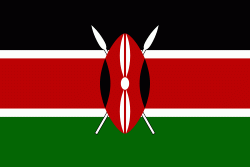Meru South District (Meru South District)
Meru South District was an unconstitutionally created district of Kenya, located in that country's Eastern Province. In 1992, it was split from the large Meru District, along with Meru Central District, Meru North District, and Tharaka District. In September 2009, the Supreme Court ruled that its creation was unconstitutional, and that it belonged in Tharaka-Nithi District (which became Tharaka-Nithi County the following year).
The area of Meru South District is the home of the Ameru tribe. The people there are now predominantly Christian — Methodist, Presbyterian, Roman Catholic, and other denominations, reflecting the work of missionaries — with minorities of Indian descent, who are mainly Hindus, and of Arab descent, who are Muslims. There are also some residents of European, predominantly British, ancestry. The Chuka people are the dominant sub-tribe in the area, occupying the more arable upepr region while the Tharaka people occupy the lower Igamba'ngombe division.
The district headquarters was in Chuka. The district had one constituency: Chuka/Igambang'ombe Constituency
The area of Meru South District is the home of the Ameru tribe. The people there are now predominantly Christian — Methodist, Presbyterian, Roman Catholic, and other denominations, reflecting the work of missionaries — with minorities of Indian descent, who are mainly Hindus, and of Arab descent, who are Muslims. There are also some residents of European, predominantly British, ancestry. The Chuka people are the dominant sub-tribe in the area, occupying the more arable upepr region while the Tharaka people occupy the lower Igamba'ngombe division.
The district headquarters was in Chuka. The district had one constituency: Chuka/Igambang'ombe Constituency
Map - Meru South District (Meru South District)
Map
Country - Kenya
 |
 |
| Flag of Kenya | |
Kenya's earliest inhabitants were hunter-gatherers, like the present-day Hadza people. According to archaeological dating of associated artifacts and skeletal material, Cushitic speakers first settled in Kenya's lowlands between 3,200 and 1,300 BC, a phase known as the Lowland Savanna Pastoral Neolithic. Nilotic-speaking pastoralists (ancestral to Kenya's Nilotic speakers) began migrating from present-day South Sudan into Kenya around 500 BC. Bantu people settled at the coast and the interior between 250 BC and 500 AD. European contact began in 1500 AD with the Portuguese Empire, and effective colonisation of Kenya began in the 19th century during the European exploration of the interior. Modern-day Kenya emerged from a protectorate established by the British Empire in 1895 and the subsequent Kenya Colony, which began in 1920. Numerous disputes between the UK and the colony led to the Mau Mau revolution, which began in 1952, and the declaration of independence in 1963. After independence, Kenya remained a member of the Commonwealth of Nations. The current constitution was adopted in 2010 and replaced the 1963 independence constitution.
Currency / Language
| ISO | Currency | Symbol | Significant figures |
|---|---|---|---|
| KES | Kenyan shilling | Sh | 2 |
| ISO | Language |
|---|---|
| EN | English language |
| SW | Swahili language |















